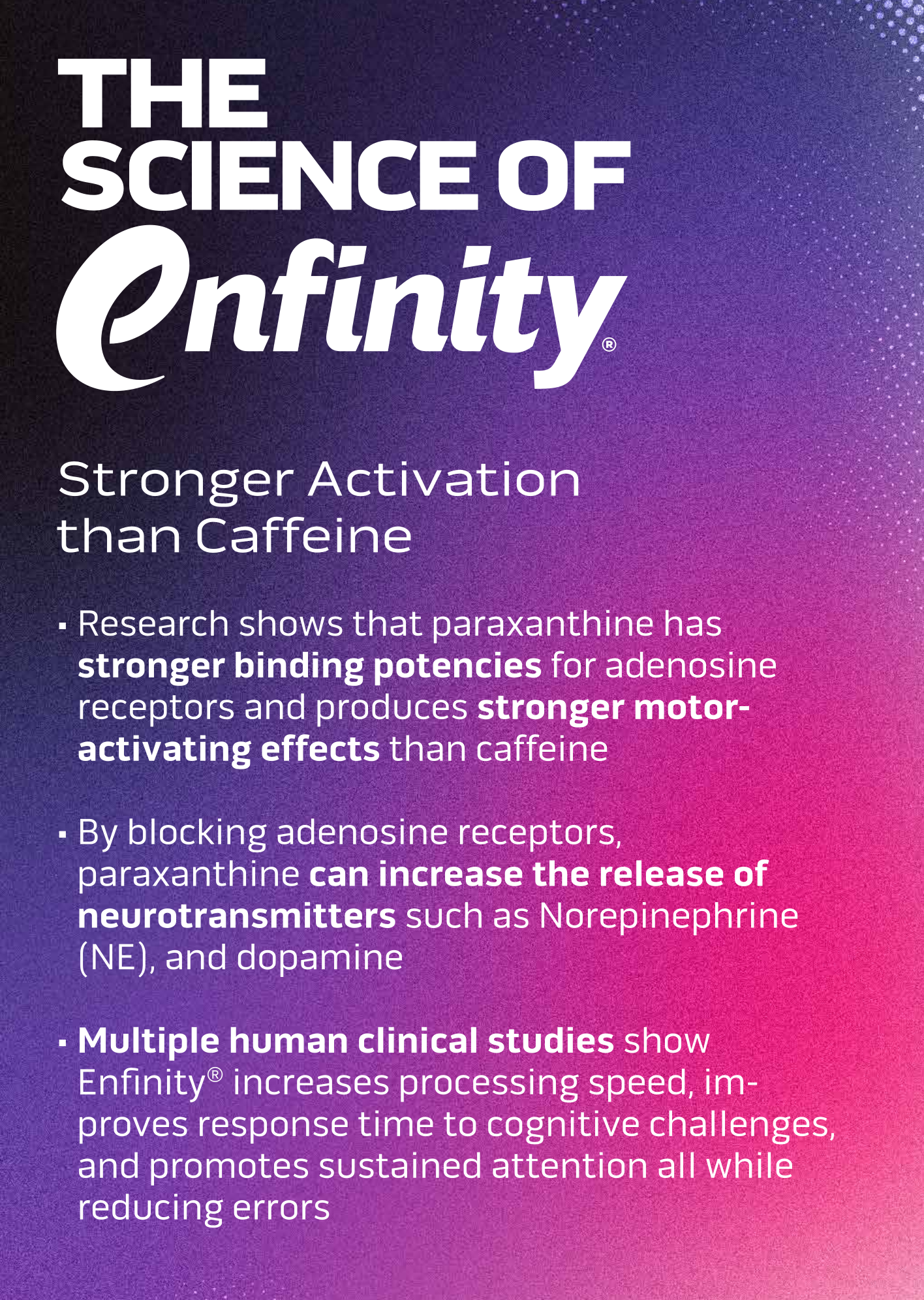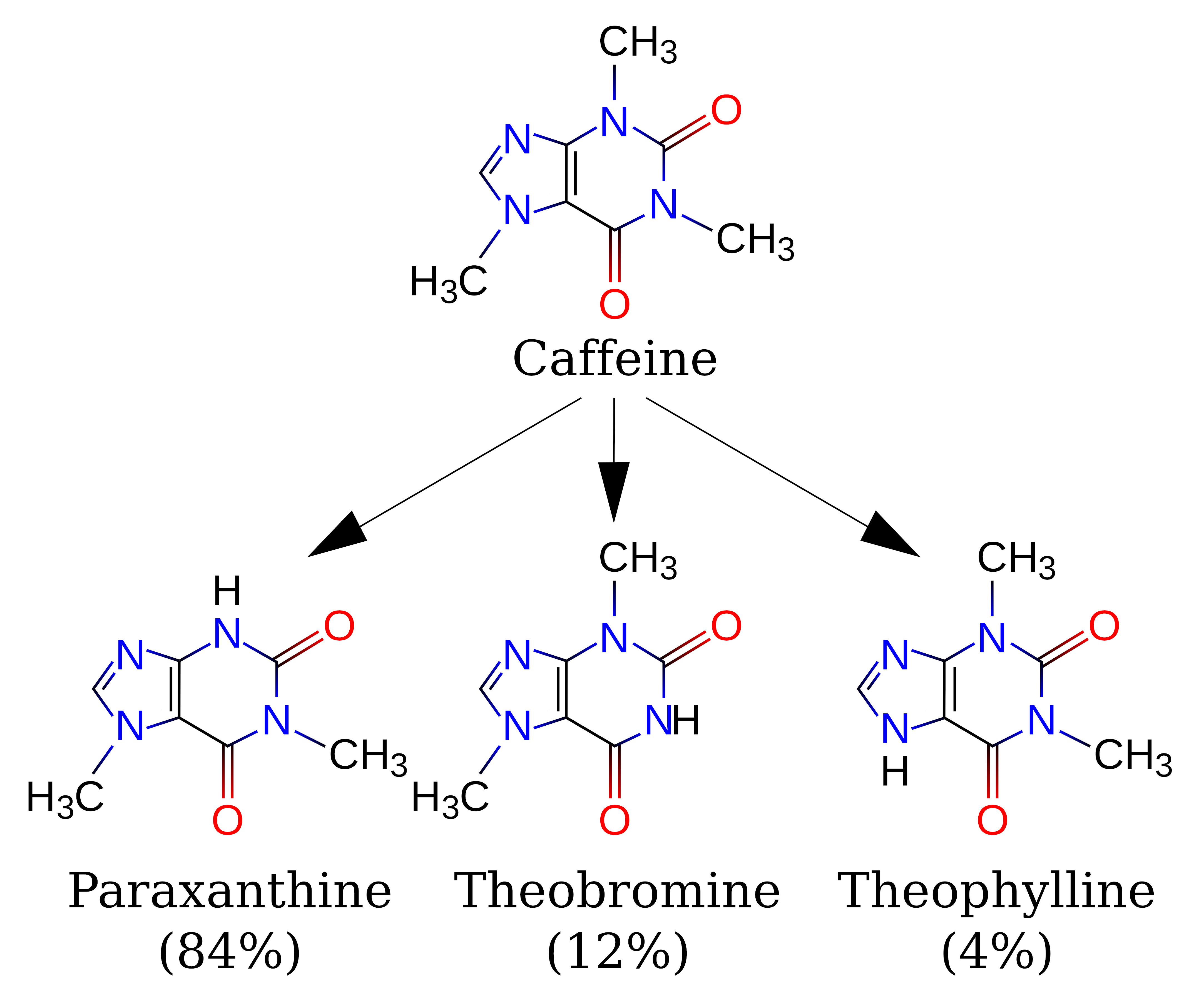[ad_1]
enfinity (paraxanthine) – 200 mg
Next we have an awesome new ingredient that’s taking the industry by storm and generating rave reviews from consumers and formulators alike. enfinity is a trademarked and patent-pending preparation of paraxanthine that’s developed by Ingenious Ingredients (ING2) and manufactured at the world-class NNB Nutrition facilities.
Long story short, paraxanthine is basically caffeine 2.0 – the best contender to replace caffeine that we’ve ever seen. It was first seen in MuscleTech’s Burn iQ themogenic fat burner (which also comes in Burn iQ Capsules) as well as the MuscleTech EuphoriQ pre-workout, and now it’s here in Alpha Test Thermo XTR as well.
So how does it work – and why would we want caffeine in a fat-burning supplement anyway?
How caffeine burns fat
Caffeine is the most ubiquitous legal drug in the world, and the reasons why it’s so popular are not mysterious. The stimulant’s ability to reduce fatigue and support cognitive and athletic performance are legendary – making it an obvious choice for inclusion in pre-workout supplements.
However, caffeine is also a potent thermogenic substance, which means it can help increase the number of calories you burn off as heat. The primary mechanism of action is its inhibition of phosphodiesterase, an enzyme that degrades a second messenger molecule called cyclic adenosine monophosphate (cAMP).[17,18]
Phosphodiesterase downregulation means cAMP upregulation, which can be a boon for metabolism since cAMP instructs your cells to generate adenosine triphosphate (ATP) from energy substrates like glucose and fatty acids.[19] In general, the more cAMP is expressed, the higher your cells’ metabolic potential.
Caffeine’s impact on cAMP signaling has a particularly significant effect on the body’s rate of fat oxidation, with some research indicating that caffeine administration can speed up the body’s rate of fat burning by roughly 50%.[20]
The obvious problem with caffeine – tolerance
Sounds amazing, right? But as we all know, there’s a catch when it comes to caffeine. Not everybody tolerates it well – in most people, it causes a certain degree of nervousness and physical agitation, and can even impair one’s ability to focus.


A brief intro to the science of paraxanthine / enfinity. Image courtesy of MuscleTech, who created the supplement with the iQ Series of supplements.
Although caffeine has been used in supplements for decades and is one of the most demanded ingredients from consumers — particularly sports supplement consumers — over time, the industry has shown an unfortunate tendency to increase caffeine dosing. In recent years, it’s gotten out of hand; doses of 300 to 400 milligrams of caffeine per serving are now common.
Recently, this trend is being met with some intense pushback and giving rise to a new trend: sharply reducing, or even eliminating, caffeine from new product formulations. At a minimum, most companies are now selling stim-free versions of popular products.
Well, thanks to paraxanthine, perhaps we can.
Paraxanthine in context – how it compares to caffeine
To understand why some of us struggle with caffeine, and how paraxanthine may be a better alternative, we need to spend some time talking about caffeine metabolism and the characteristics of its various metabolites.
Ingested caffeine goes to your liver to be metabolized and converted into one of three methylxanthine alkaloids. In order of most to least predominant, they are:
- Paraxanthine
- Theobromine
- Theophylline
While all of these metabolites have broadly similar effects, comparable to caffeine’s, there are some important differences.
Generally speaking, paraxanthine comes with the most upside and the least downside, compared to the other metabolites and to caffeine itself.
Studies show that paraxanthine can, just like caffeine, increase the body’s rate of fat burning,[21] inhibit fatigue by antagonizing the adenosine receptor,[22] and upregulate dopamine, a neurotransmitter that’s crucial for motivation, focus, and feelings of pleasure.[23]
That paraxanthine’s effects would resemble those of caffeine may not be terribly surprising – but amazingly, it appears that paraxanthine is actually better than caffeine in many respects. Research shows paraxanthine can outperform caffeine when it comes to inhibiting adenosine, improving psychomotor performance, and improving multiple dimensions of cognitive performance, including reaction times and mental accuracy.[24,25]
The same thing has been observed in sports science. Paraxanthine has an edge on caffeine when it comes to increasing muscle gains, strength, and athletic endurance.[26]


Caffeine has three major metabolites, and one of them (paraxanthine) does the heavy lifting. The other two have very long half-lives, which could be interfering with your quality of energy! Image courtesy Wikimedia
In other words, paraxanthine is what actually drives caffeine. It’s paraxanthine, not caffeine, that is best at delivering the benefits people are looking for when they quaff that second or third mug of coffee.
Caffeine’s Jekyll and Hyde problem – its metabolites
Now that we know paraxanthine is a good caffeine metabolite, what about the other two: theobromine and theophylline?
These two metabolites are a mixed bag. Theobromine does have some pretty compelling benefits, and we write about them regularly on The PricePlow Blog. Theophylline is probably the least beneficial.
But they have one thing in common, which is responsibility for much of the tolerance issues people have with caffeine – they both have a much longer biological half-life than caffeine or paraxanthine.
It’s important to note that half-life varies considerably from person to person. While based on genetics and lifestyle,[27] on average, caffeine’s half-life is roughly 4 hours.[27]
Compare this to theobromine and theophylline, which have half-lives of about 6 hours and 7 hours, respectively.[27]
The reason this matters is that all the caffeine metabolites, including theophylline and theobromine, are also stimulants . And in light of the half-life data we’ve quoted above, it’s not hard to see why that might be a problem – if you take a bunch of caffeine around 4 P.M., before your afternoon workout, your body will only clear about half the theobromine and theophylline before you go to bed at 11, which can definitely interfere with your sleep. And if you want to fall asleep even earlier, good luck.
Because roughly 28% of the caffeine you ingest gets converted to theobromine or theophylline,[28] their relatively long half-lives have to be accounted for in any honest explanation of why some people struggle with caffeine use.
Paraxanthine has the shortest half-life
In addition to providing the most benefits, at roughly 3 hours, paraxanthine has the shortest half-life.[27] Using our earlier example, if you take a bunch of paraxanthine at 4 P.M., your body will clear 80% of it by 11 o’clock.
And if you cut off all paraxanthine use by noon, your body will get rid of at least 90% of whatever paraxanthine you’ve used by 11 P.M.
More info is on the way — you can stay updated with the upcoming research in our article titled Paraxanthine: Caffeine’s Major Metabolite for Laser-Targeted Energy.
aXivite microencapsulated phenylcapsaicin Supplying 1% phenylcapsaicin – 62.5 mg
Phenylcapsaicin is a trademarked designer preparation of capsaicin, a bioactive constituent sourced from chili peppers. Capsaicin is responsible for the burning sensation chili peppers cause, which is one of those things you usually love or hate.
The designer and manufacturer of aXivite, a company called aXichem, claims that linking an additional phenyl group to the capsaicin molecule helps stabilize it and, thus, increase its potential benefit as a dietary supplement.
Increasing shelf life and chemical stability is something we generally get behind since it usually increases the value consumers get for their dollar. So, how does capsaicin benefit us?
Animal research reveals that capsaicin can increase insulin sensitivity in overfat mice while also improving glycemic control and removing adipose tissue from their livers.[29] Other studies have found that capsaicin administration can help prevent fat from building up in the liver to begin with, even in animals that consume a diet that’s very high in fat.[30]
Perhaps most impressive is the finding that capsaicin can reduce alcohol-induced liver damage.[31]
Put simply, capsaicin appears to be a tonic for liver health. And that’s a big deal, given how important liver function is for overall metabolic health. When the liver goes haywire, the result is usually insulin resistance, impaired glycemic control, and other cardiometabolic catastrophes.[32,33]
Capsaicin intake is associated with decreased production of inflammatory cytokines like tumor necrosis factor alpha (TNFα), interleukin-6 (IL-6), and monocyte chemoattractant protein-1 (MCP-1).[29]
According to a 2017 research review, just 6 mg capsaicin per day is linked to fat loss.[34] That’s far less than the aXivite dose used in MuscleTech Alpha Test Thermo XTR.
Capsaicin, like grains of paradise, can trigger non-shivering thermogenesis (NST) in brown adipose tissue (BAT),[34] leading to an increase in calories burned. Some studies show that capsaicin can inhibit the growth of adipocytes (fat cells) by decreasing adipogenesis.[34]
It’s no wonder, then, that studies in animals have found a substantial boost in total daily energy expenditure (TDEE) from capsaicin administration.[34]
Is it safe?
Of course, with a novel compound like phenylcapsaicin, we want to be sure it’s safe before taking or recommending it. And fortunately, the European Commission’s EFSA Panel on Nutrition, Novel Foods and Food Allergens (NDA), which is known for being far stricter than the FDA, has recognized phenylcapsaicin as safe for proposed applications and dosings.[31]
CaloriBurn GP Grains of Paradise Extract (as Aframomum melegueta) (seed) – 40 mg
Grains of paradise (Aframomum melegueta) contains important bioactive constituents, including a phenolic ketone called 6-paradol that can activate brown adipose tissue (BAT),[35] your body’s metabolically active type of stored fat.


When looking for quality grains of paradise, CaloriBurn from NNB Nutrition is where to get it. Learn more here and on NNBNutrition.com
Animal research shows that direct injections of isolated 6-paradol can stimulate a mechanism called non-shivering thermogenesis within existing BAT,[35] which translates into a faster metabolism and larger total daily energy expenditure (TDEE). When paired with caloric restriction and exercise, this can lead to faster fat loss, helping you achieve lean body composition more easily.[36-38]
Triggering NST in BAT comes with advantages beyond body recomposition – since brown adipocytes (fat cells) burn energy by taking in glucose and fatty acids from the bloodstream, increased BAT cell activity generally improves blood glucose and lowers serum triglycerides too.[39] Positively modifying these important cardiometabolic risk factors can help support long-term health and performance.
Human studies have also reached some impressive conclusions. In one study on adult women, grains of paradise supplementation caused sharp reductions in visceral fat, a kind of adipose tissue that’s infamous for its particularly negative effects on cardiometabolic health.[40] Consider, too, that the dose used in this study was only 30 mg/day, which is significantly less than what’s used in MuscleTech Alpha Test Thermo XTR.
In another study, just one 40 milligram dose of grains of paradise caused a significant rise in basal metabolic rate. Of course, the effect lasts for a few hours, so, in practice, this added up being just a few dozen additional calories burned – but that’s a pretty good effect size for fat-burning ingredients, especially in a study population whose metabolic health is generally in good condition to begin with.[36]
[ad_2]
Source link



